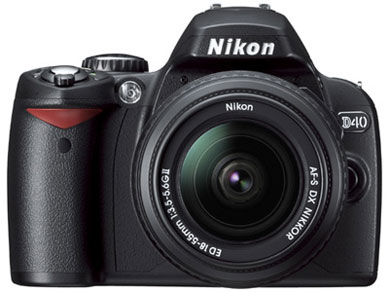Reviewer: Byer Gair
If you’re bedazzled by the Nikon name, the D40 is an economical way to experience one of its digital SLRs. It’s also a low cost way to buy into the system, allowing you to later move up to a higher-featured, more expensive body and still retain your original lenses.
There’s no mistaking the solid integrity derived from holding a Nikon D-SLR. For the price you get a finely engineered camera with 6.1 megapixels of CCD picture power, fitted with a 3x Nikkor kit lens.
Priced at the lower end of its price bracket you must forgo a higher pixel count, yet still enjoy the prestige of the name.
Having said that, the 6.1 million pixel CCD can still account for a maximum 3008 x 2000 pixel image, big enough to supply a 34 x 23 cm print, larger than A4. All that you forgo with this size sensor is the ability to severely crop a picture and still enjoy a reasonably sized image at the end of the day.
As with all D-SLRs the shot is viewed through an optical pentaprism finder before the button is pressed – and you only get to enjoy the bright image on the spacious 6.4 cm LCD screen when you preview your efforts.
While there is no inbuilt image stabiliser, Nikon stresses that its preferred approach in building such a feature into its lenses leads to more effect on shaky pictures.
Operation
In typical SLR style, the camera body has a substantial speed grip to wrap the fingers of the right hand around, with most major controls, including metering and exposure modes, shutter button, easy to access.
Nikon claims that a tally of nearly 500 shots (using flash for 50 percent of the shots) can be made, relying on a single charge of the lithium ion battery.
Features
Besides the D40’s eight scene modes for tricky shots (night portraits, sports, etc.) exposures can be made in auto, Program AE, shutter or aperture priority and manual modes. Metering in matrix, centre-weighted and spot metering is available.
An unusual option is that menu choices can be selected on the large LCD screen and displayed in ‘classic’, graphic or ‘wallpaper’ formats.
The special Retouch menu delivers in-camera image correction such as red-eye removal, cropping, image overlay and effects such as B&W conversion, colour change and adjustment.
Image capture in RAW is possible, with a simultaneous JPEG file stored on the SD memory card.
Nikon has bundled the useful PictureProject software with the camera to handle image editing chores, like image resizing and cropping, red-eye removal, retouching.Â
Performance
If you’ve always wanted a Nikon digital SLR this is your chance to invest in a quality camera at a good price.
The picture quality captured by the D40 has enjoyable colour saturation with natural flesh tones, realistic foliage colours. It takes as sharp a picture as you could want.
Conclusion
Good value and useful features are hallmarks of this camera, and its performance is reflective of the brand’s fine photographic heritage.


